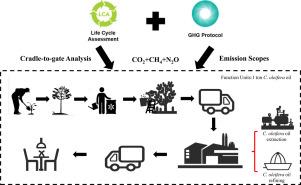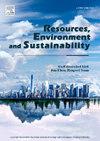中国油茶(Camellia oleifera spp.)籽油生产生命周期评价对林业可持续发展和粮食安全的影响
IF 7.8
Q1 ENVIRONMENTAL SCIENCES
引用次数: 0
摘要
随着中国推进“国家木本油籽战略(2021-2035)”以提高食用油的自给自足,协调山茶油生产与碳中和目标需要精确的排放诊断。在本研究中,利用中国37个林场和加工厂的运营数据,开发了一个新的森林制油模块。根据温室气体议定书公司标准(范围1,2 &;3),油茶油的LCA系统涵盖了从苗圃门到油厂门的所有直接(范围1),间接能源(范围2)和上游价值链(范围3)温室气体(GHG)排放(以全球变暖潜能值GWP评估)与林场运营和油厂过程相关。结果显示,每吨油茶的碳强度为3.91吨二氧化碳当量,根据中国2025年油茶产量(200万吨)计算,每年的行业排放量为781万吨二氧化碳当量。有机肥(45.27%)和复合肥(29.91%)是主要的排放源。空间分析表明,湖南(29.46%)、江西(22.43%)和广西(12.83%)三个关键省份的排放总量占全国生产排放总量的64.72%,这一差异源于区域电网排放和省际运输距离的差异。情景建模显示,通过以下方式,减排潜力为4.16-14.57%:(1)精准施肥,目标是提高25%-30%的氮肥效率;(2)加工过程中可再生能源的整合(40%的太阳能/风能渗透);(3)多式联运物流优化。这些研究结果提供了空间上明确的缓解路径,强调了省级政策平衡石油安全和脱碳目标的必要性。这些见解不仅指导林业单位降低温室气体排放,而且强调了茶油行业可持续发展的重要性,为其增强提供了必要的支持。本文章由计算机程序翻译,如有差异,请以英文原文为准。

Life cycle assessment of Camellia (Camellia oleifera spp.) seed oil production in China for forestry sustainability and food security
As China advances its National Woody Oilseed Strategy (2021–2035) to enhance edible oil self-sufficiency, reconciling camellia oil production with carbon neutrality goals demands precise emission diagnostics. In this study, a new forest-to-oil module was developed, utilizing operational data from 37 forest farms and processing plants in China. In accordance with the GHG Protocol Corporate Standard (Scope 1, 2 & 3), the LCA system for camellia oil spans from the nursery gate to the oil-mill gate, covering all direct (Scope 1), indirect energy (Scope 2) and upstream value-chain (Scope 3) greenhouse gas (GHG) emissions (assessed with global warming potential, GWP) associated with both forest farm operations and oil mill processes. Results show a carbon intensity of 3.91 t CO2-eq per ton oil, translating to annual sectoral emissions of 7.81 Mt CO2-eq based on China’s 2025 camellia oil output (2.00 million tons). Organic fertilizer (45.27% of total) and compound fertilizers (29.91% of total) dominate emission sources. Spatial analysis identifies three critical provinces—Hunan (29.46%), Jiangxi (22.43%), and Guangxi (12.83%)—collectively responsible for 64.72% of national production emissions, the disparity stems from regional grid emissions and interprovincial transport distance variations. Scenario modeling demonstrates 4.16–14.57% emission reduction potential through: (1) precision fertilization targeting 25%–30% nitrogen efficiency improvement, (2) renewable energy integration in processing (40% solar/wind penetration), and (3) intermodal logistics optimization. These findings provide spatially explicit mitigation pathways, emphasizing the necessity of province-specific policies balancing oil security and decarbonization targets. These insights not only guide forestry units in lowering their greenhouse gas emissions but also highlight the importance of sustainability in the camellia oil industry, offering essential support for its enhancement.
求助全文
通过发布文献求助,成功后即可免费获取论文全文。
去求助
来源期刊

Resources Environment and Sustainability
Environmental Science-Environmental Science (miscellaneous)
CiteScore
15.10
自引率
0.00%
发文量
41
审稿时长
33 days
 求助内容:
求助内容: 应助结果提醒方式:
应助结果提醒方式:


